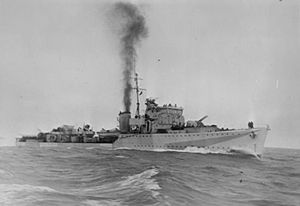HMS Quorn (L66)
 HMS Quorn underway in 1940 (IWM)
| |
| History | |
|---|---|
| Name | HMS Quorn |
| Builder | J. Samuel White and Co. at Cowes, Isle of Wight |
| Launched | 27 March 1940 |
| Commissioned | 21 September 1940 |
| Identification | Pennant number: L66 |
| Honours and awards |
|
| Fate | Sunk 3 August 1944 off the Normandy coast |
| Badge | On a Field Red,a lion's gamb erased holding a hunting horn Gold. |
| General characteristics | |
| Class and type | Hunt-class destroyer |
| Displacement |
|
| Length | 85 m (278 ft 10 in) o/a |
| Beam | 8.8 m (28 ft 10 in) |
| Draught | 3.27 m (10 ft 9 in) |
| Propulsion |
|
| Speed |
|
| Range |
|
| Complement | 146 |
| Armament |
|
HMS Quorn was a Hunt-class destroyer of the Royal Navy, built in 1940 and sunk off the Normandy coast on 3 August 1944. The class were named after British fox and stag hunts, in this case, the Quorn Hunt, predominantly based in Leicestershire.[1]
Quorn was built by J. Samuel White and Co. at Cowes, Isle of Wight. A Type 1 Hunt-class destroyer, she was launched on 27 March 1940 and completed on 21 September 1940 with the pennant number L66.[2] She was adopted by the civil community of Rushden, Northamptonshire, as part of Warship Week in 1942.
Service history
1941
Quorn joined the
In August whilst on passage from Harwich to Chatham, Quorn set off a mine 40 metres (130 ft) off her port bow. She was repaired at Chatham Dockyard. This took until September to complete.[3]
1942
In April Quorn hit another mine that blew a 9 by 15 feet (2.7 m × 4.6 m) hole in the port side of the ship. Two of ship's company were killed and one injured. Her No 1 boiler room was flooded and major structural damage sustained. She was towed to Harwich and then to Sheerness where repairs took 4 months to complete.
On 13 October Quorn was one of the five destroyers that intercepted the German
1943
North Sea convoy protection duties with the 21st Destroyer Flotilla
1944
In June Quorn was an escort for convoys of personnel during
References
- ^ The 'Hunt' class destroyer at WW2Today.com
- ^ Mason, Geoffrey B. (2004). Gordon Smith (ed.). "HMS Quorn (L 66) - Type I, Hunt-class Escort Destroyer". naval-history.net. Retrieved 4 May 2015.
- ^ a b "HMS Quorn, escort destroyer". www.naval-history.net.
- ^ Brown, p. 116
- ^ "Casualty Search". hmscavalier.org.uk.
Publications
- Colledge, J. J. & Warlow, Ben: Ships of the Royal Navy - The Complete Record of all Fighting Ships of the Royal Navy from the 15th Century to the Present. Newbury, UK: Casemate, 2010. ISBN 978-1-935149-07-1
- English, John: The Hunts - A history of the design, development and careers of the 86 destroyers of this class built for the Royal and Allied Navies during World War II. Cumbria: World Ship Society, 1987. ISBN 0-905617-44-4
- Gardiner, Robert; Chesneau, Roger, eds. (1980). Conway's All The World's Fighting Ships 1922–1946. London: Conway Maritime Press. ISBN 0-85177-146-7.
- Whitley, M. J.: Destroyers of World War Two – an international encyclopedia: Arms and Armour, 1988. ISBN 0-85368-910-5
External links
